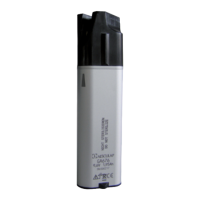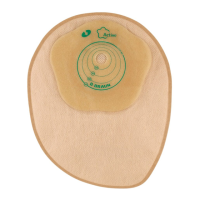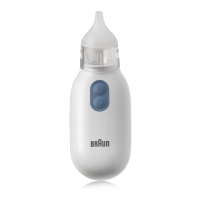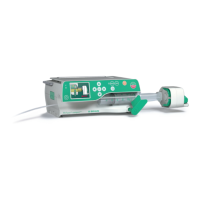8
7.7 Manual cleaning with wipe disinfection
DW: Drinking water
FD–W: Fully desalinated water (demineralized, microbiological, at least of drinking water quality)
RT: Room temperature
* Suitable enzyme solution: Helizyme, Cidezyme (the latter being used for validation purposes)
► Do not clean the product in a ultrasonic bath and do not immerse the
product in any fluids. Let any fluid incursions drain out immediately,
otherwise there is a danger of corrosion and loss of function.
Phase I
► Move flexible components (such as sleeves) during cleaning.
► Clean the product under running water, using a suitable plastic clean-
ing brush until all visible residues have been removed from the sur-
faces.
► Brush cannulation with cleaning brush TA011944 and difficult to
access surfaces with a suitable plastic cleaning brush for at least 1 min.
Phase II
► Follow the operating instructions of the enzyme cleaner with regard to
correct concentration, dilution, temperature and water quality.
► Spray products with a pH neutral enzyme solution, let soak in for at
least 2 minutes and then wipe off.
Phase III
► Move flexible components (such as sleeves) during cleaning.
► Rinse product under running tap water for at least 5 minutes.
► Follow the operating instructions of the enzyme cleaner with regard to
correct concentration, dilution, temperature and water quality.
► Remove contamination with a lint-free cloth or soft brush moistened
with enzyme cleaner.
► Rinse flexible components (such as sleeves) and cannulations for
20 seconds with the water pistol (cold water, at least 2.5 bar).
► After manual cleaning, check visible surfaces and areas of flexible com-
ponents for residues.
► If necessary, repeat the cleaning process (phase 1 to 3).
Phase IV
► Dry the product in the drying phase with suitable equipment (such as
lint-free cloths, pressurized air).
Phase V
► Wipe all surfaces of the product with a single-use disinfecting wipe.
Phase VI
► Rinse disinfected surfaces after the prescribed reaction time for at least
1 minute under running demineralized water.
► Drain any remaining water fully.
Stage VII
► Dry the product in the drying phase with suitable equipment (such as
lint-free cloths, pressurized air).
7.8 Automatic cleaning/disinfection with manual pre-cleaning
Note
The cleaning and disinfection device must fundamentally have a tested
efficacy (such as FDA approval or CE label pursuant to DIN EN ISO 15883).
Note
The cleaning and disinfection machine used for processing must be serviced
and checked at regular intervals.
7.8.1 Manual pre-cleaning with a brush
D–W: Drinking water
RT: Room temperature
► Do not clean the product in a ultrasonic bath and do not immerse the
product in any fluids. Let any fluid incursions drain out immediately,
otherwise there is a danger of corrosion and loss of function.
Phase I
► Move flexible components (such as sleeves) during cleaning.
► Thoroughly clean the product under running water.
Phase II
► Move flexible components (such as sleeves) during cleaning.
► Brush cannulation with cleaning brush TA011944 and difficult to
access surfaces with a suitable plastic cleaning brush for at least 1 min.
► After manual pre-cleaning, check visible surfaces for residue and
repeat the pre-cleaning process as required.
Phase Step T
[°C/°F]
t
[min]
Conc.
[%]
Water quality Chemicals
I Pre-cleaning RT (cold) ≥2 - D-W Until visually clean
II Cleaning with enzyme
solution
RT (cold) ≥2 0.8 D–W pH-neutral*
III Intermediate rinse RT ≥5- D-W –
IV Drying RT - - - -
V Wipe disinfection - >1 - - Meliseptol HBV wipes 50 % Propan-1-ol
VI Final rinse RT (cold) 0.5 - FD–W -
VII Drying RT - - - -
Phase Step T
[°C/°F]
t
[min]
Conc.
[%]
Water
quality
Chemistry/Note
I Rinsing RT (cold) - - D–W Until visually clean
II Brushes RT (cold) - - D–W Until visually clean
Document No.: TA014436 - Version: 1.0 - Document ID: SOP-AIC-5002244 Date/Time Printed/Viewed: 2022-04-13 16:01 (CET)
Effective

